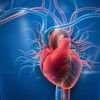How to Identify and Treat Early Heart Disease: A Comprehensive Guide
- Why Heart Disease is a Growing Concern
- Early Signs of Heart Disease
- Diagnosing Early Heart Disease
- Treating Early Heart Disease
- Lifestyle Changes to Prevent Heart Disease
1. Why Heart Disease is a Growing Concern
Heart disease remains one of the leading causes of death globally, particularly in the United States. As lifestyle choices, dietary habits, and stress levels continue to affect public health, the number of individuals suffering from heart disease has been steadily rising. What makes matters worse is that heart disease often develops silently, meaning many people do not realize they are at risk until it’s too late.
The good news is that identifying early heart disease can help mitigate the risks and even reverse some damage. Early detection through lifestyle monitoring and regular check-ups can save lives. Understanding how to identify and treat early heart disease is essential in preventing it from progressing to more severe stages, such as heart attacks or strokes.
2. Early Signs of Heart Disease
Heart disease does not typically show immediate symptoms, especially in its early stages. However, being aware of the early warning signs can help you take action before the condition worsens. The most common early signs of heart disease include:

2.1 Shortness of Breath
One of the first indicators that your heart is not functioning properly is shortness of breath. This may occur after minimal physical activity, such as walking up a flight of stairs or carrying groceries. If you experience this sensation frequently, it’s worth considering as a potential early warning sign of heart disease.
Atlanta Heart Specialists
atlanta heart specialists
4375 Johns Creek Pkwy #350, Suwanee, GA 30024, USA

2.2 Chest Pain or Discomfort
Although chest pain is often associated with a heart attack, it can also occur in the earlier stages of heart disease. People may experience a sensation of tightness, pressure, or discomfort in the chest. This discomfort may come and go, especially during physical exertion or moments of stress.
2.3 Fatigue and Weakness
Feeling unusually tired or fatigued, even after getting enough rest, can be a sign of early heart disease. The heart’s inability to pump blood effectively can lead to a lack of energy and overall weakness, making daily activities feel more exhausting than usual.
2.4 Swelling in the Legs, Ankles, or Feet
Fluid buildup in the body due to poor circulation is a common sign of heart disease. Swelling in the lower extremities, especially in the legs, ankles, and feet, may indicate that the heart is not pumping blood as efficiently as it should.
3. Diagnosing Early Heart Disease
Diagnosing early heart disease typically involves a combination of physical exams, lab tests, and imaging techniques. If you suspect you have heart disease or are at risk, it’s important to see a healthcare provider for a thorough evaluation. The most common diagnostic tests for early heart disease include:
3.1 Blood Tests
Blood tests are essential for identifying cholesterol levels, blood sugar, and other markers that can indicate heart disease risk. Elevated cholesterol or high blood sugar can damage the heart and blood vessels over time. Regular blood tests can help catch these issues early on.
3.2 Electrocardiogram (ECG or EKG)
An ECG is a test that records the electrical activity of the heart. It can help identify irregular heartbeats, previous heart attacks, or other potential signs of heart disease.
3.3 Stress Tests
A stress test evaluates how well your heart performs under physical activity. This test is often used to determine the presence of coronary artery disease, especially in individuals who experience chest pain or shortness of breath during exercise.
3.4 Echocardiogram
An echocardiogram uses sound waves to create an image of the heart’s structure and function. This test can provide valuable information about how well your heart is pumping and whether there is any damage to the heart valves or walls.
4. Treating Early Heart Disease
Early heart disease can often be managed and treated effectively with lifestyle changes, medication, and sometimes medical procedures. The treatment approach depends on the severity of the condition and your overall health. Here are the primary treatment methods for early heart disease:
4.1 Lifestyle Changes
One of the first lines of defense against heart disease is making lifestyle changes. These changes can include:
- Diet: Eating a heart-healthy diet rich in fruits, vegetables, whole grains, and lean proteins while avoiding processed foods, excessive salt, and unhealthy fats.
- Exercise: Regular physical activity, such as walking, swimming, or cycling, can strengthen the heart and improve circulation.
- Quit Smoking: Smoking is a major risk factor for heart disease. Quitting smoking is one of the most effective ways to improve heart health.
- Weight Management: Maintaining a healthy weight reduces the strain on the heart and lowers the risk of high blood pressure and diabetes.
4.2 Medications
In some cases, medications may be necessary to manage the symptoms of heart disease and prevent complications. Medications can include statins to lower cholesterol, blood pressure medications, and blood thinners to prevent clot formation.
4.3 Medical Procedures
If the condition progresses despite lifestyle changes and medication, medical procedures may be needed. These procedures can range from angioplasty and stent placement to more invasive surgeries like coronary artery bypass grafting (CABG) or valve repair/replacement.
5. Lifestyle Changes to Prevent Heart Disease
Prevention is always better than cure when it comes to heart disease. Adopting a heart-healthy lifestyle early on can significantly reduce the risk of developing heart disease. Here are some tips for maintaining a heart-healthy lifestyle:
5.1 Focus on a Healthy Diet
Eating foods that are rich in omega-3 fatty acids, antioxidants, and fiber can help reduce the risk of heart disease. Foods like salmon, leafy greens, nuts, and berries are excellent choices for heart health.
5.2 Stay Active
Engage in physical activities that increase your heart rate and improve circulation. Aim for at least 30 minutes of moderate exercise most days of the week.
5.3 Manage Stress
Chronic stress is a significant contributor to heart disease. Managing stress through relaxation techniques, hobbies, or mindfulness exercises can have a positive impact on your heart health.





















Deborah Heart and Lung Center
deborah heart and lung center
200 Trenton Rd, Browns Mills, NJ 08015, USA